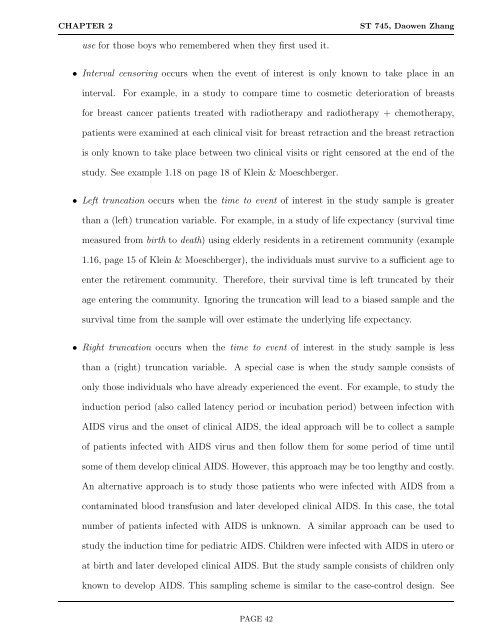2 Right Censoring and Kaplan-Meier Estimator - NCSU Statistics
2 Right Censoring and Kaplan-Meier Estimator - NCSU Statistics
2 Right Censoring and Kaplan-Meier Estimator - NCSU Statistics
You also want an ePaper? Increase the reach of your titles
YUMPU automatically turns print PDFs into web optimized ePapers that Google loves.
CHAPTER 2 ST 745, Daowen Zhang<br />
use for those boys who remembered when they first used it.<br />
• Interval censoring occurs when the event of interest is only known to take place in an<br />
interval. For example, in a study to compare time to cosmetic deterioration of breasts<br />
for breast cancer patients treated with radiotherapy <strong>and</strong> radiotherapy + chemotherapy,<br />
patients were examined at each clinical visit for breast retraction <strong>and</strong> the breast retraction<br />
is only known to take place between two clinical visits or right censored at the end of the<br />
study. See example 1.18 on page 18 of Klein & Moeschberger.<br />
• Left truncation occurs when the time to event of interest in the study sample is greater<br />
than a (left) truncation variable. For example, in a study of life expectancy (survival time<br />
measured from birth to death) using elderly residents in a retirement community (example<br />
1.16, page 15 of Klein & Moeschberger), the individuals must survive to a sufficient age to<br />
enter the retirement community. Therefore, their survival time is left truncated by their<br />
age entering the community. Ignoring the truncation will lead to a biased sample <strong>and</strong> the<br />
survival time from the sample will over estimate the underlying life expectancy.<br />
• <strong>Right</strong> truncation occurs when the time to event of interest in the study sample is less<br />
than a (right) truncation variable. A special case is when the study sample consists of<br />
only those individuals who have already experienced the event. For example, to study the<br />
induction period (also called latency period or incubation period) between infection with<br />
AIDS virus <strong>and</strong> the onset of clinical AIDS, the ideal approach will be to collect a sample<br />
of patients infected with AIDS virus <strong>and</strong> then follow them for some period of time until<br />
some of them develop clinical AIDS. However, this approach may be too lengthy <strong>and</strong> costly.<br />
An alternative approach is to study those patients who were infected with AIDS from a<br />
contaminated blood transfusion <strong>and</strong> later developed clinical AIDS. In this case, the total<br />
number of patients infected with AIDS is unknown. A similar approach can be used to<br />
study the induction time for pediatric AIDS. Children were infected with AIDS in utero or<br />
at birth <strong>and</strong> later developed clinical AIDS. But the study sample consists of children only<br />
known to develop AIDS. This sampling scheme is similar to the case-control design. See<br />
PAGE 42
















